( Written by N.R. Jayaraman )
” …….Besides the common Security features adapted
by different Countries on their Security
Documents, some special features are emerging
in the world to deter Counterfeiting menace.
The most effective format amongst them is the features
with Colour Shifting Properties which prevents forgers
from duplicating them. An brief analysis on the features…….. ”
Of late one can notice every single Bank Note/Currencies issued by different nation across the world contain Colour shift features ranging from OVI inks to several other types of Holographic images. Even though there are more than twenty time tested and universally acceptable security features are incorporated in Bank Notes and Currencies, still the features were not effectively stalling counterfeiting menace which remained unabated till few years back. The menace was challenging to the issuing authorities especially to the European nation as the value of their Currencies were considered strong in the International trade.
When the Bank Notes/ Currencies were issued several decades back, more reliance was placed on the Cotton based Paper, embedded Water Marks and the Metallic Security Thread which were considered sufficient enough to counter the menace of counterfeiting. As the counterfeiting posed serious problems, many new features were introduced to protect the Bank Notes/ Currencies .
In the mid 80s several security features were available which of course were well tested features to meet all weather conditions and ensured durability of the Notes. Various denominational Bank Notes/ Currencies issued by different countries contained some or all the security features as listed below. However all the features were not incorporated as a rule in all denominations, but the features varied with the denominational value. The higher denominational value was,the features incorporated were more while the lower denominations had limited features. However one thing found common in all Bank Notes and Currencies were the use of Cotton based Cylinder mould water mark paper embedded with two and three dimensional images as Currency to print with and the second being insertion of metallic Security thread to authenticate the notes at first look.
The most commonly used security features around the world were:
1) Cylinder mould water marked Paper with 100 % combed Cotton – Both three dimensional and two dimensional images embedded
2) Security thread- windowed or plain with printed text or without text
3) Raised print – Intaglio
4) Micro letters
5) UV glowing Florescent Inks
6) Pearl Luster Inks which had microscopic transparent Mica Flakes
7) Guilloche patterns and designs
8) Latent image
9) See through images
10) Rainbow printing
11) Blind marks
12) Iridescent Planchets
13) Magnetic inks
14) Thermo chromatic inks
15) Carefully created Halo/ Ghost images below actual images which can be viewed under powerful lens seen in a particular angle only
16) Electrotype secondary water marks
17) Florescent Metal dust called planchets ( to fluoresce on the surface of paper when viewed under UV light) and Fluorescent Fibers on paper
As the year progressed, even though sufficient features as listed above were available and incorporated as security features on security documents, the menace of counterfeiting did not come down and the Bank Notes/ Currencies were prone to attack from counterfeiters. Therefore backed by the experienced experts from the fields of optics, physics, chemistry and design continued efforts were carried out to innovate more and more features to impede counterfeiting. Many of the security features innovated remained Patented products of several firms engaged in the R&D in security features. During the period 80-90 time tested anti copying features in the form of Colour shifting features emerged which effectively checkmated the counterfeiting menace. The advent of Colour shift features was perhaps the beginning of a tough war between the Counterfeiters and the issuing authorities of security documents including Bank Notes and Currencies.
As stated initially, when the Bank Notes or Currencies were issued the issuing authorities of Bank Notes in different countries mainly relied upon the Water Mark Paper, Security thread and the specialty inks to impede counterfeiting and forgery. However with the emergence of Colour Copiers, the Bank Notes could be easily copied in true colors, a look alike notes produced on suitable Bond Paper which at first look appeared as though they were genuine Bank Notes. In view of the same certain restrictions -like when the Bank Notes or Currencies were kept for copying, the machine would produce only black and white picture or failed to copy – were imposed on the manufacturers of Colour Copiers as accepted by the international community of industries; still it had little effect in curbing the menace. Since the restrictions were only mutually acceptable and had no International legal sanction, the scheme failed to work.
Therefore in order to effectively counter the menace of counterfeiting after the advent of the Colour Copiers, the colour varying inks which changed shades when turned in different angles were innovated and introduced. M/s Sicpa, the pioneers in the field of Security Ink manufacturing came out with the novel ink technology that changed colour when viewed from two sides. The specialty ink invented called ‘Optically Variable Inks (OVI)’ could show two different shades of ink when viewed in two different angles. During 1987-88 Thailand is understood to be the first Country that adapted this technology in their currency. Initial success though was heartening, and OVI with Intaglio became an important element in the Bank Notes designs. However it was realized that the grey area in the use of OVI was limitation in shades available. Only two shade variations could be effected at that time- black to blue and Green to Black. While black to green shade was supplied to USA for incorporation in their notes the other shade available Green to Blue was open to others. Since the other OVI was not Country specific initially, the same shades could be obtained by any other Country for incorporating in their Currencies and this particular had devastating effect across the world when enemy nations were able to procure the same inks and duplicate the Currencies of their enemy nation. Therefore one or two more time tested Colour shift OVIs like Green to Violet and Green to Gold were formulated. Though invention of OVI resulted in over 90 % of the Bank Notes and Currencies now in circulation in different parts of the world carrying OVI feature, the role of OVI on Bank Notes/Currencies alone was not found sufficient enough and had to be further supplemented with another strong anti colour copying feature.
Based on the experiment of OVI emerged prismatic effect inks and OVD features. The OVD foils and patches were characterized by the iridescent display of colors when viewed from different angles. The advantage seen with the OVD was that the iridescent rays reflected by them could not be colour copied as the colored Xerox prints can not show the variation in the ink shades when the documents were viewed from different angles as the colour shifting properties of OVD was angular dependent. In respect of OVI the pigments in the ink effected shade variation. The Pigment particles used were so tiny and magnetized and specially cut like crystals to reflect different rays to show variation in colors.
With the advent of OVI and its success, slowly the choice to incorporate Colour shifting properties of products as security feature for use on Bank Notes/ Currencies gained momentum as it became impossible for counterfeiting the notes by Color copiers and other means unless they were able to procure the actual security featured material used on specific Bank Notes/Currencies.
Besides difficult to duplicate the other important aspect in the use of color shift features was that the features were more public friendly and widely accepted feature because they could be easily identified with naked eye without use of any gadgets. Specially the feature when incorporated in the form of patches, foils or threads offered more flexibility in integrating various design elements which were also not available in commercial markets. It was also found possible to incorporate the colour shifting properties on the security threads. Subsequently even double sided colour shift featured threads were developed that enabled viewing different images and colors on either side of the thread. The added advantage of the feature is the possibility of viewing the third image under transmission. One such product has been the patented product of ‘Toppan’s’ invented under brand name ‘Double sided Demet thread’. Romania is understood to be the first Country that used the colour shift thread on their Bank Notes some time during 1990.
(Pic Courtesy : Toppon.co.uk)
In the last two years it is learnt that around 100 denominations issued by several countries that include South Africa, Thailand, Costa Rica, Angola etc were incorporated with some form of colour changing features in the Bank Notes/ Currencies issued. This will illustrate that next to the Paper and Ink the level of security for Bank Notes and Currencies tilted to colour changing features that played an important role in strengthening the security features of the documents like Passports, Visa, Driving Licenses including that of Bank notes.
Varieties of Colour Shifting property features are available world over many of them being Patented products of some firms. Some of the features are in the form of Kinegram, Hologram or OVD foils or OVI in inks. An optical variable device or optically variable device (OVD) is an iridescent image that exhibits various optical effects such as movement or color changes which cannot be even colour copied or scanned to produce multiple copies.
Since OVDs are based on diffractive optical structures and gave appearance of having different patterns, colors, and designs depending on the angle from which they are viewed, the first use of a holographic OVD (Optically Variable Device) as security feature was adapted on a Banknote in the year 1989. Optically Variable Device (OVD) has commonly been used as security feature for showing iridescent display of colors. OVD show various tilt effects like kinematic effects and colour shifts. All innovations like Kinegram® , Holograms and other varieties of holographic mediums used as Bank Note protection feature came under under OVD family.
Toppon, a UK based firm came out with several OVDs as security features. The firm, pioneers in the manufacture of Holograms are in the field from 1975. The firm claim that their OVDs are in use on more than 12 billion Bank Notes across the world. Some of their patented products on OVD by Toppon has been the following:
- Crystagrams:- These are supplied with Nano and Micro texts. One of their ‘S’ type Crystograms when rotated through 90 degrees show both negative and Positive images.
Crystagrams
‘S’ Type Crystagrams
(Pic Courtesy : Toppon.co.uk)
- Asterium:- This when viewed straight will cause the image to appear black and when tilted, show clear image in two color shades.
(Pic Courtesy : Toppon.co.uk)
- Nanorius:- Like Hologram, it has colour shift effect, but unlike colour shift ink, micro-level text and images can be achieved.
(Pic Courtesy : Toppon.co.uk)
- Jeweltone :- This is also under OVD family but with nano level moulding technology. It gives three colour effects, first tilt will show black and white image. Further tilt will show third colour effect or design change compared to original image.
(Pic Courtesy : Toppon.co.uk)
The Kinegram®, a vector oriented Colour shift security feature also came under the family of OVD. Kinegram® is proprietary technologies from Kurz, a German firm and their product is understood to have been introduced first in Saudi Arabian Passport in the year 1980. In the year 1988 Austria brought out 5000 Schilling Bank Note which is the first foil application under Kinegram.The Kinegram® contains special types of computer-generated diffractive optical elements with symmetric and asymmetric surface reliefs (gratings). It is the world’s leading foil based optical security device for the production of Bank Notes and other security documents and is a custom made. A Kinegram image is formed by fine lines of different thickness and shape. As angle of the light changes, the image of Kinegram also changes, producing the effect of even a moving picture. It has two dimensional images and when Kinegram image is tilted both in horizontal and vertical axis one can see changes in the images like moving, rotating, changing colour effect images or change the image pattern itself. This is called Kinematic effect. This feature can not be copied or imitated, the product being proprietary technology of Kurz and technology kept secret.
The Kinegram images are produced through diffractive theory deploying e-beam and high resolution laser and by combining the two images produced by them through precision process the final Kinegram image is produced. Apart from diffractive control elements, it is claimed by the firm that it is possible to integrate some of the security features directly on to Kinegram foils by printing on them. As per the information from the firm over 100 countries have adapted Kinegram® technology for various security documents produced by them that include Bank Notes and Currencies.
(Pic Courtesy : Kinegram.com)
Further to Kinegram® Kurz has come out with another feature called ‘Kinegram Volume®’ which is fundamentally different and show only one colour in narrow viewing range but have an exceptional diffraction efficiency that results in clear and bright images with depth and display large colour shifts in one patch. They are also transparent and show the images printed below Kinegram Volume (Information Courtesy : Currency News, May 2013).
‘Kinegram Volume®’ on photo polymer material is foil based technology that produces highly visible, clear images under all standard lighting conditions with very sharp image transitions.
(Pic Courtesy : Kinegram.com)
(Pic Courtesy : Currency News, May 2013 issue)
Another OVD group of Colour shift security feature is known as Holography which enables viewing of three dimensional images. Though the Rainbow effect has been introduced in the Hologram in the year 1969, the Holographic feature has been reportedly introduced as security feature on Bank Notes only from the year 1980 as the embossed rainbow Holograms were available in commercial market only from then. With suitable illumination combined with the use of laser, interference, and intensity of light beam scattered from the object, both the 2D and 3D images are formed. The Holographic technique is photography based to produce three dimensional images. Various types of Holograms made under this technique include transmission holograms that allow light to be shined through them and the image to be viewed from the side, while others are Rainbow Holograms. One advanced amongst them is called Holographic stereo gram, which is used to enhance the security of documents including that of Currencies and Bank Notes.
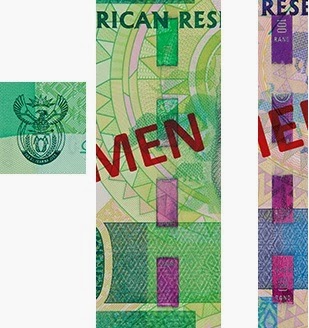
As the world’s largest integrated commercial banknote printer De La Rue have also come out with several innovative security features in the Colour shift Holographic feature. De La Rue Holographic is world leader in Optical Micro Structure technology, specializing in high security anti-counterfeit and tamper-evident technologies. De La Rues’ holograms are reportedly used on over 90 denominations covering more than 40 countries. The firm claim that their Holographic products have sharper resolution, deeper images, controlled colour effect, and the technique not available in the commercial markets. The effects seen in their Holograms are distinctly different, has instant public recognition properties, simple to verify and rated to be the highest feature in anti counterfeit features available. The firm has few Colour shift Holographic features some of which are:-
- Depth image TM Hologram: Visible depth in images, easily recognized by public, can be applied as OVD patch.
- Dual image TM Hologram: Three dimensional images and can be applied in OVD patch format
- Combigram TM Hologram: combination of classical and E beam technologies in perfect register with covert features integrating different OVD effects.
- Multi image TM Hologram: Can be applied as stripes, combinable with Dual image Hologram

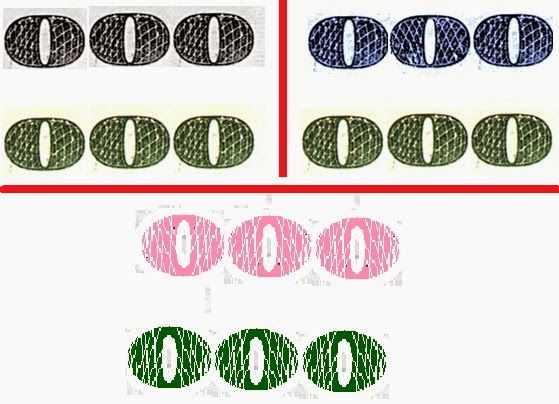
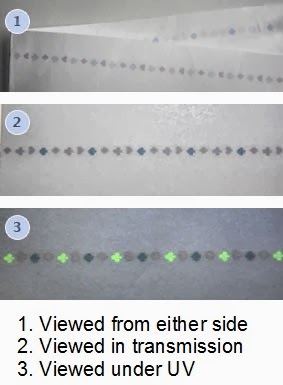
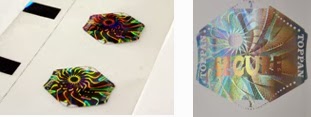
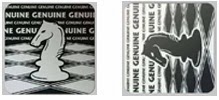
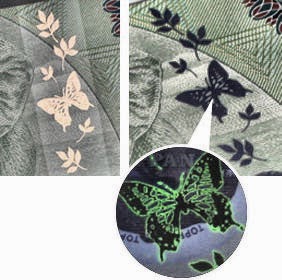
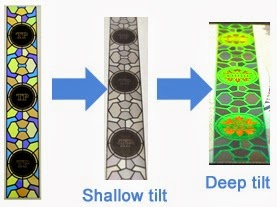
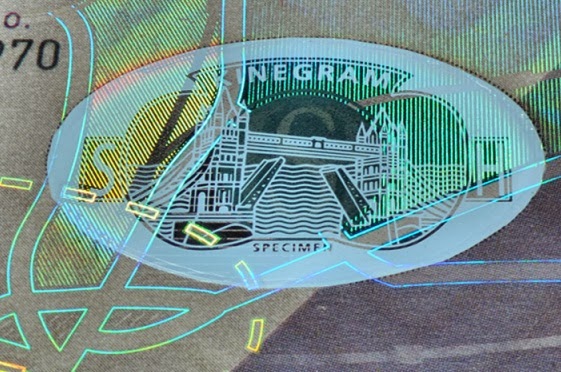
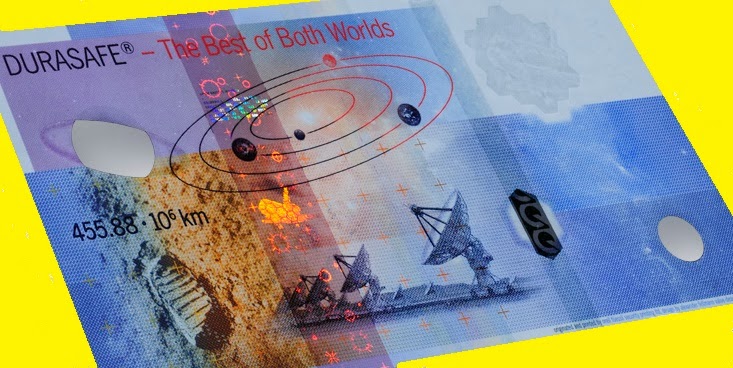
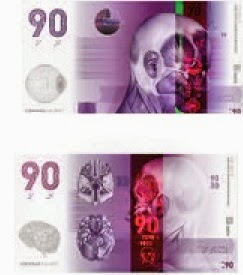

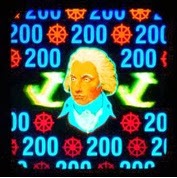

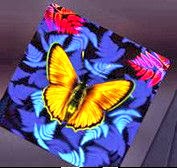
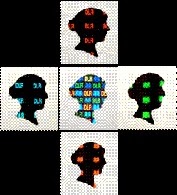















Recent Comments